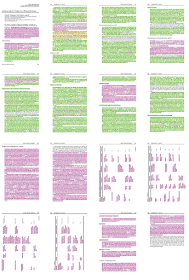However, there has been some discussion online suggesting that quite a few people do not consider that self-plagiarism is a problem at all. For example, Dr Adriano Aguzzi of the University of Zürich sees no harm in it:
That said, Dr Aguzzi does attach a couple of conditions to his support for authors recycling their own text:Today's rant is about academic "self-plagiarism". As the Editor-in-Chief of a medical journal, I thought long and hard about this issue. I have concluded that self-plagiarism is a non-existing crime. There is no moral imperative why authors should not re-use their own words.— Adriano Aguzzi (@AdrianoAguzzi) July 20, 2020
[[ Update 2020-07-25 10:28 UTC: Dr Aguzzi seems to have deleted the above tweets, along with the rest of the thread in which they appeared. I had taken a screenshot of the first one, and @deadinsideg1 kindly hunted down the second.4. My only constraint is that (1) republication be labelled as such, and (2) that copyright legislation be respected. But forcing people to paraphrase the exactly same concepts with different words, that may be a useful exercise for secondary school - but not for scientists.— Adriano Aguzzi (@AdrianoAguzzi) July 20, 2020
]]
I opened Dr Aguzzi's Google Scholar page and looked for the most-cited article for which he was the lead author, which was this:
Aguzzi, A., & Polymenidou, M. (2004). Mammalian prion biology: One century of evolving concepts. Cell, 116(2), 313–327. https://doi.org/10.1016/S0092-8674(03)01031-6
A little searching online revealed that this was the starting point for a succession of examples of self-plagiairism, or "republication", or what Dr Aguzzi prefers to call it. In fact, as we will see, Dr Aguzzi takes a very liberal approach to recycling—or perhaps, in the modern parlance, upcycling—his previous publications.
Let's start with the 2004 Aguzzi & Polymenidou article:
The text highlighted in yellow here(*) appears to have been copied, verbatim and without attribution, to this 2006 article by the same author:
Aguzzi, A. (2006). Prion diseases of humans and farm animals: Epidemiology, genetics, and pathogenesis. Journal of Neurochemistry, 97(6), 1726–1739. https://doi.org/10.1111/j.1471-4159.2006.03909.x
In the second of Dr Aguzzi's tweets that I quoted earlier, he made a point that republication should be labelled, and copyright respected. Strangely, however, not only does the 2006 article not mention that parts of the text were previously published; the later article does not even include the 2004 article in its References section. (For completeness, in case the publication pipeline had gone slightly awry, I checked the References section of the 2004 article, but it didn't mention the 2006 article as being "in preparation" or anything like that.) Furthermore, the 2004 article is copyrighted by Cell Press, a division of Elsevier, while the 2006 article is copyrighted by the International Society for Neurochemistry (and the journal is published by Wiley). So it seems that neither of Dr Aguzzi's constraints are met here.
Some parts of the text in the above image are highlighted in green. That brings us to another article, this time with Dr Aguzzi as second author:
Weissmann, C., & Aguzzi, A. (2005). Approaches to therapy of prion diseases. Annual Review of Medicine, 56, 321–344. https://doi.org/10.1146/annurev.med.56.062404.172936
Again, the text highlighted in yellow here appears to have been copied, verbatim and without attribution, from the 2004 article mentioned above. The text highlighted in green appears to have been copied, verbatim and without attribution, from the 2006 article. The 2005 article does not include the 2006 or the 2004 article in its References section, or vice versa. Copyright for the 2005 article is owned by Annual Reviews.
Another new highlight colour (pink) appears here, especially in the second half. The more astute reader may be able to work out where we are going here. Adding the yellow, green, and pink text together, we arrive at close to 95% of the content of this book chapter:
Aguzzi, A. (2007). Prions. In J. H. Growdon and M. N. Rossor (Eds.), The Dementias 2 (pp. 250–275). Butterworth-Heinemann.
So, back to the question in the title. Is self-plagiarism a bad thing? Dr Aguzzi clearly doesn't think so, and one can only admire the consistency of his position relative to his actions (although he might want to consider addressing the issues around labelling and copyright). I happen to think that this sort of thing is extremely bad for science, but it appears to be sufficiently common that maybe we are going to have to just live with it, and accept that some people think that churning out the same material over and over is perfectly acceptable.
[[ Update 2020-07-23 23:55 UTC: Thanks to Brendan O'Connor for this link to the Association for Psychological Science's policy on self-plagiarism. Spoiler: They are not too keen on it. ]]
(*) I have made the full-sized images and the annotated PDF files available for download here. I hope that this counts as fair use for the purposes of this blog post. If the owners of the copyright want to object to this, I hope that they will realise the irony that would be involved if they decided to enforce their rights now.
(*) I have made the full-sized images and the annotated PDF files available for download here. I hope that this counts as fair use for the purposes of this blog post. If the owners of the copyright want to object to this, I hope that they will realise the irony that would be involved if they decided to enforce their rights now.





